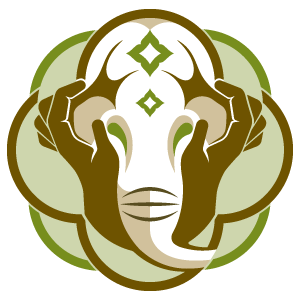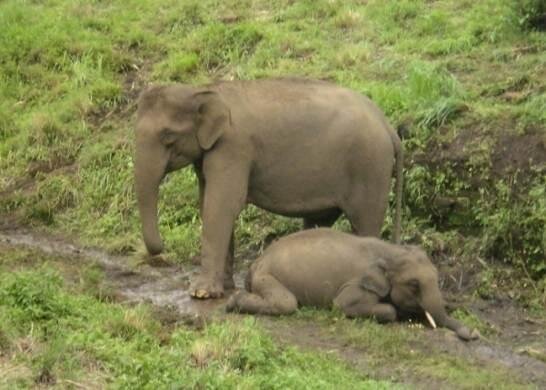Elephant Endotheliotropic Herpesvirus
In 1995, Kumari, at 16 month-old Asian elephant died after a short illness at the Smithsonian’s National Zoo. Zoo pathologists soon discovered that a previously unidentified herpesvirus, later called Elephant Endotheliotropic Herpesvirus (EEHV) was responsible.
Zoo pathologists, veterinarians, researchers, and private owners have all come together to investigate the transmission and epidemiology, develop better treatments, and create a possible vaccine to save elephants from this too often fatal disease. Much has been learned about this disease since it was first described in 1995, but there is much more to be learned.
At first, it was thought that housing Asian and African elephants together was the source of the virus in Asian elephants, but that has been shown to not be true; Asian elephants in the wild also have the EEHV virus with the same breadth of diversity as seen in elephants in human care. This is not a disease found only in Western institutions. It is a natural herpesvirus of elephants, and is most likely found in all elephants, both Asian and African. Did you know that most species, including humans, have herpesviruses associated with them that have evolved over millions of years to co-exist with their host?
Generally, Asian elephants from birth to age 8 are most at risk for EEHV; recently African elephants up to age 13 years have also gotten sick and died from EEHV. Scientists haven’t discovered why some Asian elephants quickly succumb to EEHV and others carry it latently with no symptoms. The typical illness presentation is a quick physical decline with lethargy, discolored tongue, or facial and neck swelling¹. Up to 20% of calves in human care are at risk of fatal hemorrhagic disease, and once it strikes, EEHV has an 85% mortality rate with a very short window for antiviral treatment with supportive care. Antivirals are used, but it is not known if they are effective, or if it is the supportive care that is saving the calves. It has been shown that rapid treatment is most effective. The prevalence of EEHV in the wild populations aren’t known at this time.
The statistics are horrific and represent dashed hopes for the life of a new calf and broken hearts among their caregivers. Despite this, there is amazing talent and experience working around the clock at Smithsonian’s National Zoo, John Hopkins University, Baylor College of Medicine, and more around the world that are dedicated to saving today’s elephants. We applaud and appreciate their efforts on behalf of all Asian elephants.
Wild elephant populations are experiencing loses due to EEHV. This picture of a mom guarding her dying calf sends a powerful message.
Only 30,000 to 50,000 Asian elephants remain in the wild, scattered across fragmented habitats in 13 Asian countries. EEHV is a significant threat to the survival of this vulnerable species. The formation of the Asian EEHV Advisory Group together with the National Elephant Herpes Laboratory (NEHL) providing training, chemical reagents, and diagnostic equipment in Southeast Asia – with the collaborative support of AES and other organizations – is a critical step toward successfully confronting this disease in Asian range countries. Make no mistake; it won’t be easy or quick. But almost 100 cases have been confirmed in Asia to date, with many more deaths suspected but unconfirmed because of the difficulty of diagnosing EEHV in wild elephants and the lack of testing capacity in the range countries. After accurate diagnosis in the lab comes training in the field, for owners and mahouts to be able to identify and respond in the small window this disease offers for possible survival.
More research is needed on how the free ranging elephant population has been affected by emerging diseases such as EEHV. As this free ranging population shares habitat with captive elephants, livestock, and human settlements, there is an important need for long-term wildlife health monitoring of the elephant populations. There is also a need to determine the extent that environmental factors, such as habitat loss, contribute to the emergence of disease of Asian elephants.
What We Are Doing
Knowledge and good science represent the real hope for the future of this magnificent species. Obviously, there is much more work to be done. To this end, AES is continuing to partner with scientists, veterinarians, and other organizations concerned about Asian elephant health. Asian Elephant Support continues to focus support on continuing the study of EEHV in Asian elephant populations around the world. Each life is precious, not only to the population, but to the future of the species. Please consider making a donation to AES today to help support additional research and efforts that are needed to protect the next generation of Asian elephants.
Special Announcement
AES has designated funds available for researchers, veterinarians or other organizations doing work in Asia to combat this virus. Please contact us with further questions or complete the Grant Application process outlined under our Partner Resources page. Your application will be considered by the AES Board at our next regularly scheduled Board Meeting following the submittal of your application.
Further Reading:
EEHV Testing Capacity-Building in Asia, Facilitated by the EEHV Asia Working Group
Recommendations from the 1st Asian EEHV Strategy Meeting
Simon Y. Long, Erin M. Latimer, Gary S. Hayward, Review of Elephant Endotheliotropic Herpesviruses and Acute Hemorrhagic Disease, ILAR Journal, Volume 56, Issue 3, 24 February 2016, Pages 283–296, https://doi.org/10.1093/ilar/ilv041




